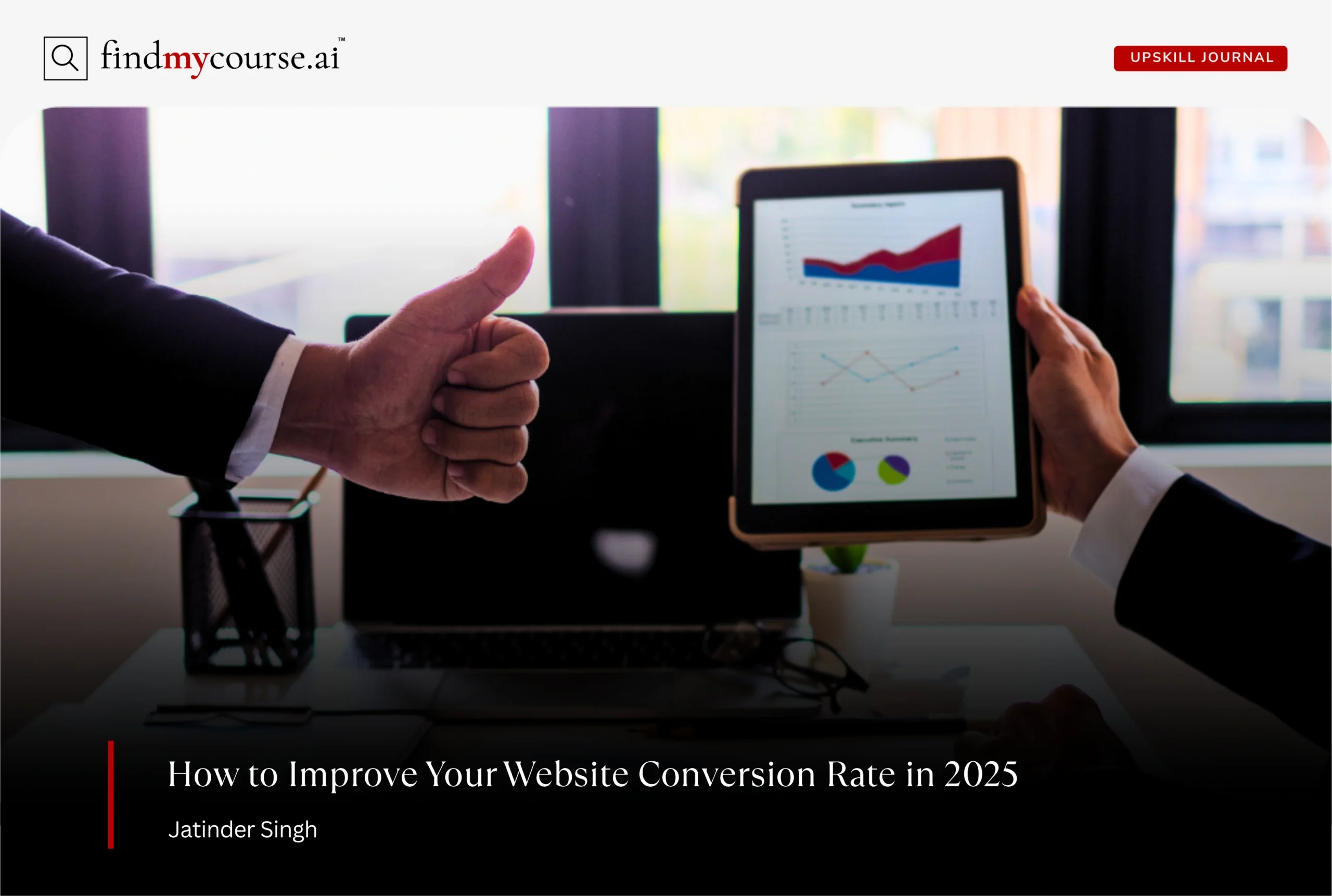Every click on your website is an opportunity—an opportunity to inspire action, capture interest, and turn a casual visitor into a loyal customer. Yet, too many websites fail to convert because they focus solely on traffic instead of how users engage. And that’s where website conversion rate becomes a game-changer.
In 2025, mastering conversion optimization isn’t just a nice-to-have skill—it’s essential for anyone looking to upskill in digital marketing, UX, or professional growth. Moreover, small changes, from refining landing pages to personalizing content, can dramatically increase engagement and revenue. This guide will walk you through practical, proven strategies to enhance your website’s conversion rate, transform visitor behavior, and ensure every interaction counts.
Understanding Website Conversion Rate
Your website conversion rate is the percentage of visitors who take a desired action on your site, such as:
- Making a purchase
- Signing up for a newsletter
- Filling out a contact form
A higher conversion rate signals that your website effectively persuades visitors to act. In 2025, businesses with optimized conversion paths experience up to 30% more engagement, according to recent industry studies.
Why Website Conversion Rate Matters
Conversion rate directly affects business growth. More conversions mean more leads, revenue, and also opportunities for upselling or cross-selling. Moreover, it reflects how well your website aligns with user expectations—an essential factor for professional growth and digital upskilling.
Practices and Strategies for Improving Website Conversion Rate
Improving your website’s conversion rate is not just about tweaking buttons or forms—it’s about understanding your audience, optimizing every interaction, and also continuously refining your approach. Below are nine key strategies that, when applied thoughtfully, can transform casual visitors into loyal customers.
1. Analyze User Behavior for Smarter Decisions
Understanding how visitors engage with your site is the foundation of conversion optimization. Moreover, without insight into user behavior, even the best design or content may fall short.
- Leverage Analytics Tools
Start by observing how visitors interact with your website. Tools like Google Analytics, Hotjar, or Microsoft Clarity provide detailed insights into visitor behavior as they show which pages have high bounce rates or where users drop off in the conversion funnel. This information is also critical for making informed improvements. - Identify Key Pain Points
Beyond raw numbers, heatmaps and session recordings reveal friction points. For example, confusing navigation or unclear calls to action can prevent conversions. Once you spot these challenges, you can also develop targeted solutions that enhance the user journey and keep visitors engaged.
2. Optimize Landing Pages for Maximum Impact
Landing pages are often the first impression a visitor has of your offer, so clarity and focus are essential.
- Create Focused Landing Pages
Each landing page should have a singular purpose. So, avoid clutter or distracting elements that could divert users from the main call to action. For example, a page promoting a webinar should prioritize registration over unrelated content. - Use Clear Messaging
Headlines, subheadings, and body content must clearly convey value. Additionally, consistency between ads, emails, and landing pages builds trust and motivates visitors to act, creating a smoother path to conversion.
3. Enhance User Experience (UX) Across Devices
A seamless, intuitive user experience encourages visitors to stay longer and take action.
- Prioritize Mobile Responsiveness
By 2025, over 70% of web traffic comes from mobile devices. So, a responsive design ensures your site adapts to every screen, delivering a smooth experience for all users. - Improve Site Speed
Slow-loading pages drive visitors away. Optimize images, implement browser caching, and follow modern coding standards to reduce load times. Moreover, studies show that even a one-second delay can reduce conversions by up to 7%. - Streamline Navigation
Menus, search functionality, and logical page hierarchies make it easy for visitors to explore. A clear path to your CTA prevents frustration and keeps users moving toward conversion.
4. Use A/B Testing to Refine Your Strategy
Small changes can have a huge impact on conversions—but only if you test them systematically.
- Test Headlines and CTAs
A/B testing lets you compare different page versions to see which performs best. Try testing headlines, CTA text, button colors, or placement to identify what resonates most with your audience. - Iterate and Adapt
Conversion optimization is never a one-time task. By continuously testing and refining your website, you can stay ahead of user expectations and industry trends.
5. Build Trust Through Social Proof
Visitors are more likely to act when they trust your brand.
- Showcase Testimonials and Reviews
Customer testimonials, case studies, and ratings provide social proof. Real experiences build credibility and motivate users to take action. - Highlight Security and Credibility
Display SSL certificates, payment security badges, and industry certifications. These trust signals reassure visitors that your website is safe and reliable.
6. Simplify Forms to Reduce Friction
Forms are critical for conversion, but complex or long forms can push users away.
- Ask Only for Essential Information
Limit form fields to what is necessary, and consider features like autofill. Simplifying forms reduces friction and improves completion rates. - Use Step-by-Step or Multi-Part Forms
For longer applications or surveys, break forms into smaller steps. This approach reduces cognitive load and encourages users to finish the process.
7. Personalize User Experience with Dynamic Content
Personalization makes visitors feel valued and understood, increasing their likelihood to convert.
- Segment Visitors
Tailor content based on user behavior, location, or previous interactions. For instance, showing product recommendations based on browsing history creates relevance. - Increase Engagement
Dynamic content demonstrates attention to user needs. When visitors feel recognized, they respond more positively to your calls to action.
8. Craft Clear and Compelling Calls to Action
Your CTA is the gateway to conversion—make it impossible to miss.
- Make CTAs Stand Out
Use contrasting colors, bold text, and strategic placement to draw attention. A well-designed CTA guides visitors seamlessly toward the desired action. - Use Action-Oriented Language
Instead of generic “Submit” buttons, use benefit-driven language like “Get Your Free Guide” or “Start Your 7-Day Trial.” This encourages immediate action.
9. Continuously Monitor and Adapt
The digital landscape changes constantly, and so do user behaviors.
- Stay Updated with Trends
Keep up with new tools, emerging UX patterns, and conversion optimization research. Continuous learning ensures your website remains competitive. - Evaluate Metrics Regularly
Track conversion rate, click-through rate, and engagement metrics to measure success. Regular evaluation allows you to refine strategies and maintain steady growth.
Tools and Sources for Optimizing Website Conversion Rate
Optimizing your website’s conversion rate relies on the right tools and reliable data. Analytics platforms, UX testing tools, and industry reports provide insights to guide improvements and track performance effectively.
| Category | Tool/Source | Purpose |
| Analytics | Google Analytics | Track traffic, user behavior, and conversion funnels |
| UX Testing | Hotjar | Heatmaps and session recordings to identify friction points |
| A/B Testing | Optimizely | Test page variations to improve conversions |
| Personalization | Dynamic Yield | Tailor content based on user behavior |
| Reports | Nielsen Norman Group | UX best practices and benchmarks |
Start with analytics to understand visitor behavior, complement with UX and A/B testing tools for improvements, and consult credible reports to align with industry trends. Using these tools together helps make informed decisions, refine user experience, and ultimately boost your website conversion rate.
Conclusion
Improving your website conversion rate is a journey, not a one-time task. By understanding your audience, optimizing user experience, testing strategically, and leveraging the right tools, every interaction can be turned into meaningful action. The strategies outlined here provide a roadmap to transform visitors into loyal customers while keeping your site competitive in 2025. Focus on continuous learning and adaptation—small, thoughtful improvements today will yield significant growth tomorrow. And if you ever have questions or need guidance along the way, our AI assistance is here to help.


